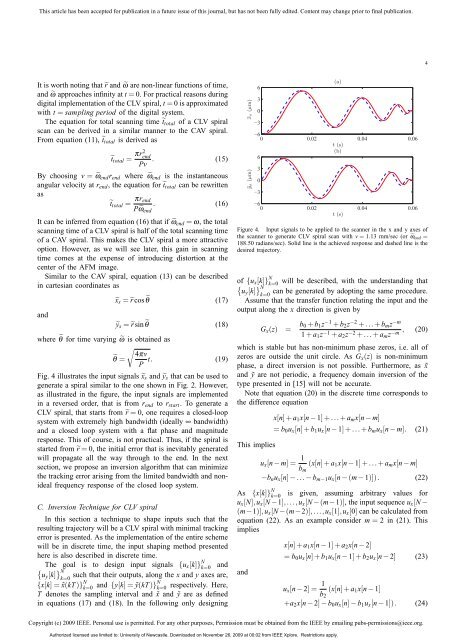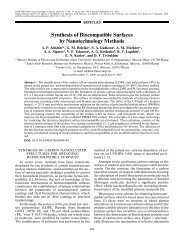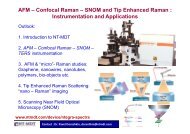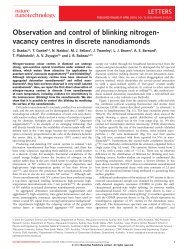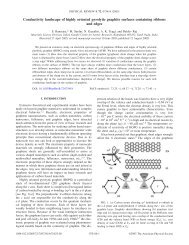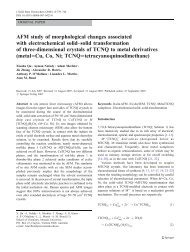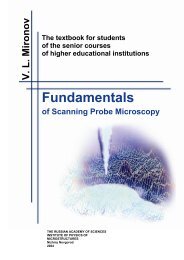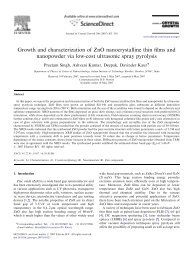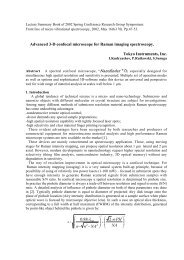This article has been accepted <strong>for</strong> publication in a future issue of this journal, but has not been fully edited. Content may change prior to final publication.4It is worth noting that ˜r and ˜ω are non-linear functions of time,and ˜ω approaches infinity at t = 0. For practical reasons duringdigital implementation of the CLV spiral, t = 0 is approximatedwith t = sampling period of the digital system.The equation <strong>for</strong> total scanning time ˜t total of a CLV spiralscan can be derived in a similar manner to the CAV spiral.From equation (11), ˜t total is derived as˜t total = πr2 endPv . (15)By choosing v = ˜ω end r end where ˜ω end is the instantaneousangular velocity at r end , the equation <strong>for</strong> ˜t total can be rewrittenas˜t total = πr endP˜ω end. (16)It can be inferred from equation (16) that if ˜ω end = ω, the totalscanning time of a CLV spiral is half of the total scanning timeof a CAV spiral. This makes the CLV spiral a more attractiveoption. However, as we will see later, this gain in scanningtime comes at the expense of introducing distortion at thecenter of the AFM image.Similar to the CAV spiral, equation (13) can be describedin cartesian coordinates asand˜x s = ˜r cos ˜θ (17)ỹ s = ˜r sin ˜θ (18)where ˜θ <strong>for</strong> time varying ˜ω is obtained as√4πv˜θ = t. (19)PFig. 4 illustrates the input signals ˜x s and ỹ s that can be used togenerate a spiral similar to the one shown in Fig. 2. However,as illustrated in the figure, the input signals are implementedin a reversed order, that is from r end to r start . To generate aCLV spiral, that starts from ˜r = 0, one requires a closed-loopsystem with extremely high bandwidth (ideally ∞ bandwidth)and a closed loop system with a flat phase and magnituderesponse. This of course, is not practical. Thus, if the spiral isstarted from ˜r = 0, the initial error that is inevitably generatedwill propagate all the way through to the end. In the nextsection, we propose an inversion algorithm that can minimizethe tracking error arising from the limited bandwidth and nonidealfrequency response of the closed loop system.C. Inversion Technique <strong>for</strong> CLV spiralIn this section a technique to shape inputs such that theresulting trajectory will be a CLV spiral with minimal trackingerror is presented. As the implementation of the entire schemewill be in discrete time, the input shaping method presentedhere is also described in discrete time.The goal is to design input signals {u x [k]} N k=0 and{uy [k] } Nsuch that their outputs, along the x and y axes are,k=0{x[k] = ˜x(kT)} N k=0 and {y[k] = ỹ(kT)}N k=0 respectively. Here,T denotes the sampling interval and ˜x and ỹ are as definedin equations (17) and (18). In the following only designing˜xs (µm)ỹs (µm)630360 0.02 0.04 0.06t (s)(b)6303(a)60 0.02 0.04 0.06t (s)Figure 4. Input signals to be applied to the scanner in the x and y axes ofthe scanner to generate CLV spiral scan with v = 1.13 mm/sec (or ˜ω end =188.50 radians/sec). Solid line is the achieved response and dashed line is thedesired trajectory.of {u x [k]} N k=0 will be described, with the understanding that{uy [k] } Ncan be generated by adopting the same procedure.k=0Assume that the transfer function relating the input and theoutput along the x direction is given byG x (z) =b 0 + b 1 z −1 + b 2 z −2 +...+b m z −m1+a 1 z −1 + a 2 z −2 , (20)+...+a m z−m which is stable but has non-minimum phase zeros, i.e. all ofzeros are outside the unit circle. As G x (z) is non-minimumphase, a direct inversion is not possible. Furthermore, as ˜xand ỹ are not periodic, a frequency domain inversion of thetype presented in [15] will not be accurate.Note that equation (20) in the discrete time corresponds tothe difference equationThis impliesx[n]+a 1 x[n − 1]+...+a m x[n − m]= b 0 u x [n]+b 1 u x [n − 1]+...+b m u x [n − m]. (21)u x [n − m] = 1b m(x[n]+a 1 x[n − 1]+...+a m x[n − m]−b n u x [n] −... − b m−1 u x [n −(m − 1)]). (22)As {x[k]} N k=0 is given, assuming arbitrary values <strong>for</strong>u x [N],u x [N −1],...,u x [N −(m−1)], the input sequence u x [N −(m−1)],u x [N −(m−2)],...,u x [1],u x [0] can be calculated fromequation (22). As an example consider m = 2 in (21). Thisimpliesandx[n]+a 1 x[n − 1]+a 2 x[n − 2]= b 0 u x [n]+b 1 u x [n − 1]+b 2 u x [n − 2] (23)u x [n − 2] = 1 b 2(x[n]+a 1 x[n − 1]+a 2 x[n − 2] − b 0 u x [n] − b 1 u x [n − 1]). (24)Copyright (c) 2009 IEEE. Personal use is permitted. For any other purposes, Permission must be obtained from the IEEE by emailing pubs-permissions@ieee.org.Authorized licensed use limited to: University of <strong>New</strong>castle. Downloaded on November 26, 2009 at 00:02 from IEEE Xplore. Restrictions apply.
This article has been accepted <strong>for</strong> publication in a future issue of this journal, but has not been fully edited. Content may change prior to final publication.5Setting u x [N] and u x [N − 1] to arbitrary values, u x [N − 2]can be back calculated from equation (24). Similarly, usingthe calculated u x [N − 2] and the arbitrarily chosen u x [N − 1],u x [N −3] can be computed. Thus, traversing backwards in timeone can compute u x [n] up to n = 0.The above mentioned procedure can be proved to be stable,and can be shown to converge to an input sequence that wouldgenerate the output ˜x(kT). However, the proof is beyond thescope of this paper. If a user has to deal with a continuoustime transfer function G x (s), he or she could approximateit by a discrete transfer function G x (z) using the bilineartrans<strong>for</strong>mation or any other approximation technique.D. Total scan time: Spiral scan vs. Raster scanA fair comparison of the total scanning time <strong>for</strong> spiral andraster scans can be made by evaluating the time required <strong>for</strong>both methods to generate images of equal areas and pitchlengths. The area of a circular spiral scanned image A spiralwith a radius of r end can be calculated asA spiral = πr 2 end . (25)The area of a rectangular raster scanned image A raster can becalculated usingA raster = L 2 (26)where L is length of the square image. For both images to havean equal area, equations (25) and (26) are equated to obtainL = √ πr end . (27)The number of lines in a raster scanned image with pitch Pcan be calculated asnumber o f lines = L + 1. (28)PThe total scan time to generate a raster scanned image can beobtained usingt total raster =number o f linesf(29)where f is the scan frequency. Thus, by substituting equations(27) and (28) into equation (29), the total scan time <strong>for</strong>generating a raster scanned image with an area of πrend 2 canbe determined ast total raster =√πrendP f+ 1 f . (30)The total scanning time to generate a spiral scanned imagein a CAV mode can be calculated using equation (6) and bysubstituting ω = 2π f into equation (6),t total = r endP f . (31)It can be deduced from equations (30) and (31), by ignoringthe term 1 fin equation (30), <strong>for</strong> the same scan frequency, animage of equal area and pitch can be generated √ π (≈ 1.77)times faster using a CAV spiral scan than a raster scan.In order to compare the total scanning time <strong>for</strong> a CLV spiralscan and a raster scan, the linear velocity of the raster scanv r = 2L f is introduced into equation (30) to obtainedt total raster = 2πr2 endPv r(32)with the term 1 fignored. It can be deduced from equations(32) and (15), <strong>for</strong> the same linear velocity, v r = v, an imageof equal area and pitch can be generated two times faster usinga CLV spiral scan than a raster scan.E. Total trajectory distance : Spiral scan vs. Raster scanIn this section, total trajectory distance in generating imagesof equal area and pitch length using spiral and raster scans arecompared. The total trajectory distance of a spiral scan s spiralcan be derived from equation (15) ass spiral = πr2 endP . (33)Note that, (33) also holds <strong>for</strong> a CAV spiral scan.The total trajectory of a raster scan s raster can be written ass raster = 2L × number o f lines. (34)By substituting equations (28) and (27) into equation (34),s raster can be obtained ass raster = 2πr2 end+ 2 √ πr end . (35)PIt can be deduced from equation (35) and (33) that, s raster isat least two times longer than s spiral . An immediate advantageof this is that, there will be less wear on the AFM tip whenthe spiral scan is used instead of the raster scan.F. Mapping Spiral Points to Raster PointsIn this work, the spiral-scanned images are plotted bymapping the sampling points along the spiral trajectory (called“spiral points”) to points or pixels (called “raster points”) thatmake up a raster-scanned image placed on top of the spiralpoints as shown in Fig. 5 (a) and (b) <strong>for</strong> CAV and CLV spiralsrespectively. A major advantage of mapping the spiral pointsto the raster points is that it allows the user to utilize existingimage processing software developed specifically <strong>for</strong> rasterscannedimages, to plot the generated spiral image.In this mapping procedure, the dimension of the rasterscannedimage is set to spiral diameter × spiral diameterwhere the spiral diameter ≈ spiral radius × 2, and the pitchof the raster-scanned image is chosen to be equal to thepitch P of the spiral. Consequently, the number of lines inthe raster-scanned image will be equal to the number ofcurves in the spiral trajectory. Then, each raster point locatedwithin the spiral radius is mapped to the nearest spiral point.Since position of the raster and spiral points are known <strong>for</strong>any scan frequency and dimension, the nearest spiral pointcorresponding to each raster point can be identified and storedin an indexed matrix be<strong>for</strong>e per<strong>for</strong>ming the sample scans. Bydoing this, the image of the sample can be plotted in real-time,i.e., as the AFM is scanning the sample.Copyright (c) 2009 IEEE. Personal use is permitted. For any other purposes, Permission must be obtained from the IEEE by emailing pubs-permissions@ieee.org.Authorized licensed use limited to: University of <strong>New</strong>castle. Downloaded on November 26, 2009 at 00:02 from IEEE Xplore. Restrictions apply.


